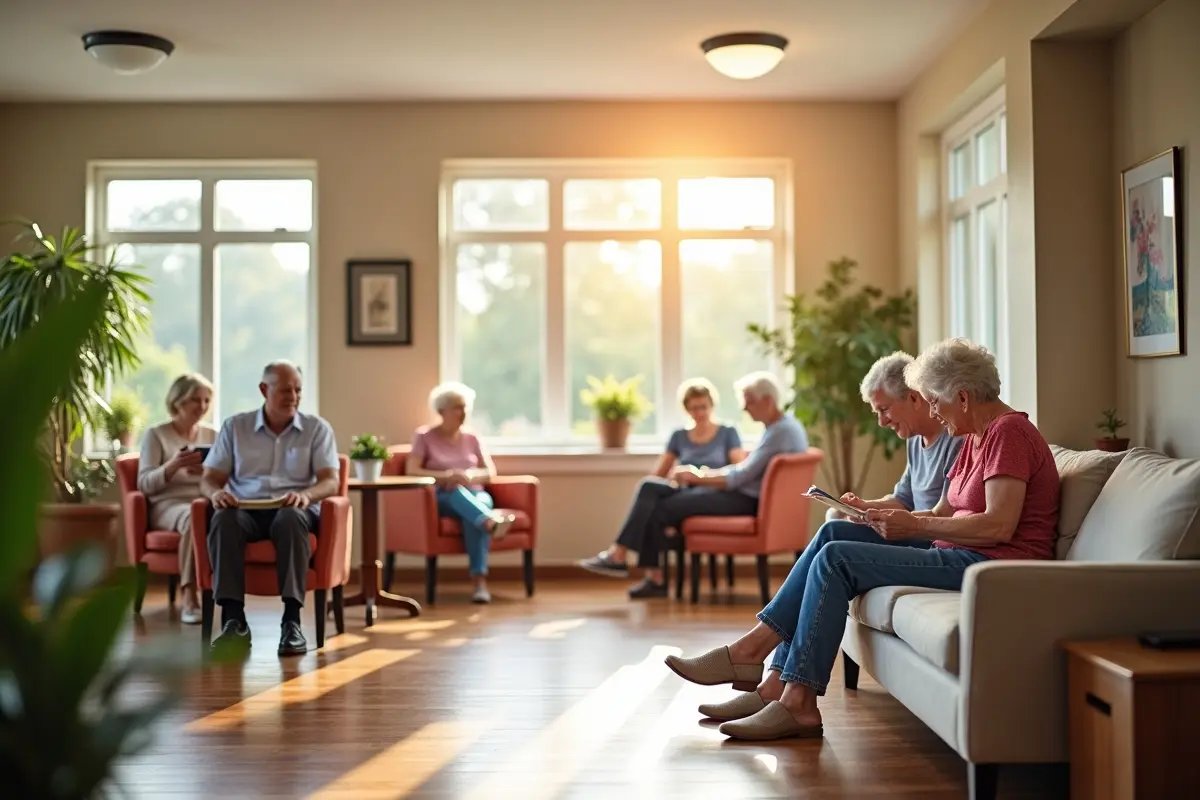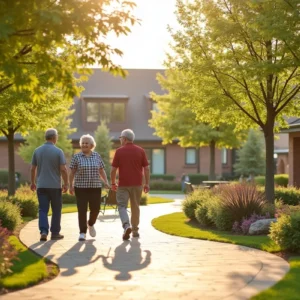As loved ones search for the right environment to support aging parents or relatives, understanding and addressing daily living needs becomes fundamental. These needs encompass a spectrum of essential activities, such as personal hygiene, dressing, grooming, meal preparation, and medication management, which together form the backbone of daily routines.
In a senior living community in Visalia, CA, these foundational activities are handled with deep compassion and professional expertise, ensuring that residents maintain their independence and dignity even as they receive the daily support they require.
Managing these activities involves establishing structured routines that bring comfort and predictability, but also allowing enough flexibility to honor residents’ personal preferences, cultural traditions, and longstanding habits. By valuing each individual’s unique background and personality, senior living environments foster autonomy and self-esteem, two pillars integral to overall happiness and well-being.
In communities that prioritize these aspects, resident satisfaction rates are notably higher, and transitions into care are often smoother, promoting a greater sense of acceptance and well-being as residents settle into their new homes.
The goal is to create an environment in which seniors feel empowered and supported, not simply cared for. This means staff take the time to learn about each resident’s personal story, likes, and dislikes, weaving these preferences into every aspect of daily living. By making daily tasks more personalized, seniors are more likely to remain engaged, active, and optimistic — factors that are closely connected to overall health outcomes.
Contents
- 1 Personalized Care Plans: Tailoring Support to Individual Needs
- 2 Integrating Technology to Enhance Daily Living
- 3 Promoting Social Engagement to Combat Loneliness
- 4 Ensuring Nutritional Well-being Through Thoughtful Dining Services
- 5 Addressing Safety and Emergency Preparedness
- 6 Training Staff to Meet Evolving Care Demands
- 7 Fostering a Holistic Approach to Daily Living Management
Personalized Care Plans: Tailoring Support to Individual Needs
Individualized care plans are the cornerstone of high-quality senior living. Each resident’s health, mobility, and routines are carefully assessed upon moving in, leading to a tailored plan that adapts as their needs evolve.
This bespoke approach ensures a respectful balance between assistance and independence—residents receive only the help they need while retaining control over their daily lives. For example, some individuals may require assistance only with medication or meal preparation, while others may need comprehensive daily support with activities such as bathing and dressing.
Person-centered planning also involves families and medical professionals, keeping everyone informed and engaged in the care process. Collaborative care planning not only ensures the physical safety and health of residents but also supports their psychological well-being by building relationships based on trust.
According to the AARP’s Caregiving Resource Center, this collaborative dynamic fosters trust and reassures families that their loved ones are valued as individuals, not just as numbers. Regular reviews and updates ensure that the care plan is always aligned with the resident’s changing health and preferences, offering peace of mind to both residents and families.
Integrating Technology to Enhance Daily Living
Innovative technologies are transforming senior living facilities and redefining what is possible for daily living assistance. Features such as voice-controlled devices, smart medication dispensers, and automated lighting systems make day-to-day tasks easier and safer for those with mobility or memory concerns.
These solutions enhance seniors’ ability to manage their environment independently, boosting confidence and reducing the risk of accidents or missed medications. Telehealth options expand residents’ access to healthcare professionals, reducing stress for those who have difficulty traveling and improving care outcomes through more frequent and convenient medical consultations.
Technology also connects seniors to the broader world, enabling video calls with family, access to virtual enrichment activities such as online classes or book clubs, and reminders for important routines. As highlighted by The New York Times, these advancements are closing gaps in care and dramatically increasing residents’ feelings of inclusion and independence. For families, these digital connections can provide daily reassurance, reduce anxiety about loved ones’ isolation, and strengthen bonds across distances.
Promoting Social Engagement to Combat Loneliness
Social connection is fundamental for emotional health and a critical component of effective daily living management. Creating opportunities for group activities, clubs, and celebrations helps combat isolation, which can be detrimental to both physical and mental health. A 2025 survey by the Pew Research Center indicates that 35% of seniors experience feelings of loneliness or isolation at least sometimes, highlighting the importance of robust engagement programs in senior living communities.
Active engagement and regular interaction help foster friendships and a sense of belonging. Staff members who encourage participation and offer support for those with social anxieties or cognitive decline play a pivotal role in residents’ well-being and happiness.
Senior living communities often employ dedicated activity coordinators who design inclusive events to appeal to a wide range of interests and abilities—from art and music therapy programs to intergenerational events involving local youth, ensuring every resident has the opportunity to stay socially involved.
Furthermore, the physical design of senior communities—such as comfortable lounges, activity rooms, and outdoor spaces—supports informal socialization, making it easy for residents to gather for coffee, games, or conversation without the barriers that many seniors face when living alone. Fostering these connections can improve mood, self-worth, and even cognitive function.
Ensuring Nutritional Well-being Through Thoughtful Dining Services
Proper nutrition underpins every aspect of a senior’s life, from cognitive function and mood to immunity and energy levels. Senior living communities are increasingly focused on creating diverse, appealing menus that cater not only to medical needs but also to personal tastes, religious beliefs, and cultural traditions.
Seasonal fruits and vegetables, whole grains, and heart-healthy choices form the foundation of these dining programs, often enhanced by locally sourced ingredients and chef-led culinary demonstrations that make mealtimes an event to look forward to.
Registered dietitians and chefs collaborate to provide flexible, resident-centered options that respect allergies, diabetic requirements, and cultural dietary preferences. Special attention is paid to food texture and hydration to accommodate residents who may have difficulty swallowing or require modified diets.
Communal dining further enriches the experience, offering another avenue for social engagement, discovery, and enjoyment, while also allowing staff to monitor residents’ nutritional intake and spot early warning signs of health concerns.
For many seniors, flexibility and variety at mealtimes make a real difference. Options like all-day dining or themed nights can keep routines fresh and exciting, supporting nutrition by making healthy choices enjoyable and accessible.
Addressing Safety and Emergency Preparedness
Safety is integral to quality senior living. Comprehensive emergency protocols—ranging from fall prevention strategies to plans for natural disasters—are essential in protecting residents. Facilities regularly review procedures and train staff to respond to a wide array of situations, taking cues from recent real-world events such as Hurricane Ida, where preparedness proved vital for senior facility residents. Emergency drills involving both residents and staff help ensure readiness and build confidence that everyone knows what to do, no matter the situation.
Simple environmental adaptations, such as grab bars, non-slip flooring, and emergency call systems, complement staff vigilance and contribute to an environment where seniors and their families feel confident and secure. The CDC’s resources on aging and emergency preparedness offer valuable guidance for facilities aiming to exceed safety standards.
These practices aren’t merely about compliance but about fostering a continual culture of safety—where staff, residents, and families alike know that wellbeing is at the forefront of daily life.
Training Staff to Meet Evolving Care Demands
The increasingly complex health profiles of residents demand skilled and empathetic caregivers. Senior living staff receive ongoing education in chronic disease management, dementia care, medication protocols, and other relevant topics.
Comprehensive training enables swift responses to health issues and a proactive approach to addressing emerging needs. Whether handling a sudden medical concern or supporting behavioral changes due to dementia, well-trained staff are essential for quality, resident-centered care.
Education also helps staff support emotional and cognitive health, recognizing early signs of isolation or cognitive decline and intervening with compassion. This commitment to continual learning ensures the highest standards of care throughout every stage of aging. Additionally, regular feedback from residents and families, along with mentorship among staff members, fosters ongoing skill development, empathy, and adaptability.
Fostering a Holistic Approach to Daily Living Management
Addressing daily living needs in senior living environments requires a holistic perspective. By integrating personalized care plans, adopting new technologies, prioritizing social and nutritional wellness, investing in thorough staff training, and ensuring robust safety measures, senior living communities are setting new standards for resident well-being. These efforts must be unified under an overarching philosophy of respect and dignity, where each resident is seen as a whole person with a lifetime of experiences and value.
This multifaceted strategy honors every aspect of a resident’s life—not only supporting physical health but nurturing emotional fulfillment and human connection. The result is a community where seniors are empowered to live their best lives, embraced by care and compassion, and supported every step of the way as they age with dignity, joy, and confidence.





